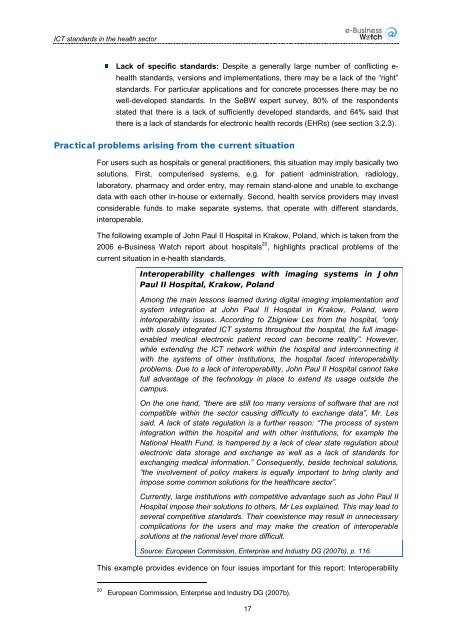ICT standards in the health sector: current situation and ... - empirica
ICT standards in the health sector: current situation and ... - empirica
ICT standards in the health sector: current situation and ... - empirica
Create successful ePaper yourself
Turn your PDF publications into a flip-book with our unique Google optimized e-Paper software.
<strong>ICT</strong> <strong>st<strong>and</strong>ards</strong> <strong>in</strong> <strong>the</strong> <strong>health</strong> <strong>sector</strong>Lack of specific <strong>st<strong>and</strong>ards</strong>: Despite a generally large number of conflict<strong>in</strong>g e-<strong>health</strong> <strong>st<strong>and</strong>ards</strong>, versions <strong>and</strong> implementations, <strong>the</strong>re may be a lack of <strong>the</strong> “right”<strong>st<strong>and</strong>ards</strong>. For particular applications <strong>and</strong> for concrete processes <strong>the</strong>re may be nowell-developed <strong>st<strong>and</strong>ards</strong>. In <strong>the</strong> SeBW expert survey, 80% of <strong>the</strong> respondentsstated that <strong>the</strong>re is a lack of sufficiently developed <strong>st<strong>and</strong>ards</strong>, <strong>and</strong> 64% said that<strong>the</strong>re is a lack of <strong>st<strong>and</strong>ards</strong> for electronic <strong>health</strong> records (EHRs) (see section 3.2.3).Practical problems aris<strong>in</strong>g from <strong>the</strong> <strong>current</strong> <strong>situation</strong>For users such as hospitals or general practitioners, this <strong>situation</strong> may imply basically twosolutions. First, computerised systems, e.g. for patient adm<strong>in</strong>istration, radiology,laboratory, pharmacy <strong>and</strong> order entry, may rema<strong>in</strong> st<strong>and</strong>-alone <strong>and</strong> unable to exchangedata with each o<strong>the</strong>r <strong>in</strong>-house or externally. Second, <strong>health</strong> service providers may <strong>in</strong>vestconsiderable funds to make separate systems, that operate with different <strong>st<strong>and</strong>ards</strong>,<strong>in</strong>teroperable.The follow<strong>in</strong>g example of John Paul II Hospital <strong>in</strong> Krakow, Pol<strong>and</strong>, which is taken from <strong>the</strong>2006 e-Bus<strong>in</strong>ess Watch report about hospitals 20 , highlights practical problems of <strong>the</strong><strong>current</strong> <strong>situation</strong> <strong>in</strong> e-<strong>health</strong> <strong>st<strong>and</strong>ards</strong>.Interoperability challenges with imag<strong>in</strong>g systems <strong>in</strong> JohnPaul II Hospital, Krakow, Pol<strong>and</strong>Among <strong>the</strong> ma<strong>in</strong> lessons learned dur<strong>in</strong>g digital imag<strong>in</strong>g implementation <strong>and</strong>system <strong>in</strong>tegration at John Paul II Hospital <strong>in</strong> Krakow, Pol<strong>and</strong>, were<strong>in</strong>teroperability issues. Accord<strong>in</strong>g to Zbigniew Les from <strong>the</strong> hospital, “onlywith closely <strong>in</strong>tegrated <strong>ICT</strong> systems throughout <strong>the</strong> hospital, <strong>the</strong> full imageenabledmedical electronic patient record can become reality”. However,while extend<strong>in</strong>g <strong>the</strong> <strong>ICT</strong> network with<strong>in</strong> <strong>the</strong> hospital <strong>and</strong> <strong>in</strong>terconnect<strong>in</strong>g itwith <strong>the</strong> systems of o<strong>the</strong>r <strong>in</strong>stitutions, <strong>the</strong> hospital faced <strong>in</strong>teroperabilityproblems. Due to a lack of <strong>in</strong>teroperability, John Paul II Hospital cannot takefull advantage of <strong>the</strong> technology <strong>in</strong> place to extend its usage outside <strong>the</strong>campus.On <strong>the</strong> one h<strong>and</strong>, “<strong>the</strong>re are still too many versions of software that are notcompatible with<strong>in</strong> <strong>the</strong> <strong>sector</strong> caus<strong>in</strong>g difficulty to exchange data”, Mr. Lessaid. A lack of state regulation is a fur<strong>the</strong>r reason: “The process of system<strong>in</strong>tegration with<strong>in</strong> <strong>the</strong> hospital <strong>and</strong> with o<strong>the</strong>r <strong>in</strong>stitutions, for example <strong>the</strong>National Health Fund, is hampered by a lack of clear state regulation aboutelectronic data storage <strong>and</strong> exchange as well as a lack of <strong>st<strong>and</strong>ards</strong> forexchang<strong>in</strong>g medical <strong>in</strong>formation.” Consequently, beside technical solutions,“<strong>the</strong> <strong>in</strong>volvement of policy makers is equally important to br<strong>in</strong>g clarity <strong>and</strong>impose some common solutions for <strong>the</strong> <strong>health</strong>care <strong>sector</strong>”.Currently, large <strong>in</strong>stitutions with competitive advantage such as John Paul IIHospital impose <strong>the</strong>ir solutions to o<strong>the</strong>rs, Mr Les expla<strong>in</strong>ed. This may lead toseveral competitive <strong>st<strong>and</strong>ards</strong>. Their coexistence may result <strong>in</strong> unnecessarycomplications for <strong>the</strong> users <strong>and</strong> may make <strong>the</strong> creation of <strong>in</strong>teroperablesolutions at <strong>the</strong> national level more difficult.Source: European Commission, Enterprise <strong>and</strong> Industry DG (2007b), p. 116.This example provides evidence on four issues important for this report: Interoperability20European Commission, Enterprise <strong>and</strong> Industry DG (2007b).17
















